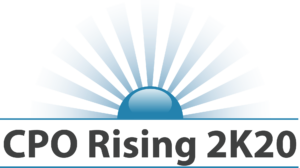Ardent Partners takes the severity of the COVID-19 pandemic with the utmost seriousness. Please click here to read our approach in these uncertain times.
From March 31 through May 7, Ardent Partners will host The CPO Rising 2K20 – The Resiliency Imperative an exciting new online series that focuses on the key strategies that procurement, supply chain, finance, and HR leaders will need to get through this period of adversity.
This series is comprised of web-based presentations, panels, and interviews with leading business executives, industry analysts, and other experts, as well as Ardent’s latest research on resiliency, agility, and the State of Procurement. Live sessions will run from March 31 through May 7 when the Virtual Summit is held. Recordings of each session will be available on the event site. Be sure to check back frequently as exciting new sessions will be added to the schedule.
The Resiliency Imperative – Part 1: An Economic Recession Looms
As the COVID-19 pandemic continues to sweep the globe at an alarming pace, we believe that it is prudent to revisit some of the predictions we made at the beginning of the year (and one that we did not), before the virus became potentially the most disruptive event of this decade. As we are experiencing — directly or indirectly — the COVID-19 pandemic is changing almost everything, at least for the moment. The way we work, where we work, and how and what we plan are all in flux, as are what and where we source, and what and where we manufacture. It’s also casting in a new light what we value (as workers, business leaders, people, and citizens), what our goals are, what adversity looks like, what success looks like, and who or what the value drivers are in a world besieged by the worst pandemic since the 1918 Spanish Flu outbreak. In a matter of weeks, COVID-19 has changed it all — starting with our outlook for the year.
In full disclosure, Ardent Partners had been predicting for the prior two years that a global economic recession or slowdown would occur. But, “based on our priors,” as they say in the statistical world, record high stock market performance, soaring consumer confidence, and historically-low unemployment, we did not predict that a recession would hit the global and US economies in 2020. In fact, we believed that the global economy, although fraught with heightened volatility and uncertainty, would continue to power through this year. Few predicted that a Black Swan-event, such as the Coronavirus, would catch us flatfooted in late winter, although epidemiologists and public health officials had been warning for years that it was just a matter of when, not if, something like this would occur. Infectious diseases and viral outbreaks were the stuff of novels and movies, or they simply didn’t happen “here.” But here we are.
Thus, we now believe that a global economic recession is imminent, and likely already in progress. Quarterly GDP reports will tell us definitively in early July (two consecutive quarters of negative GDP growth constitute a recession), but there are several prominent indicators that this is occurring now. Over the past month, global market indexes have dropped considerably, with the Dow Jones Industrial Average losing roughly 9,000 points since February 20 and sending the bull market into bear territory. In early March, following failed OPEC negotiations, Saudi Arabia cut its oil prices and increased its production in an effort to recoup market share lost to Russian oil producers. Oil prices have fallen dramatically, trading now at less than $25 a barrel — below 2008-2009 recession prices — and increasing market volatility. Consumer confidence in the US and globally has also dropped, down 23% in the Morning Consult Consumer Confidence Tracker.
By mid-March, as community spread of COVID-19 became apparent in North America and Europe, the US and other global economies began to see a public health crisis mounting. COVID-19 transmission models were showing that between 40% and 70% of people in the US, alone, would contract the virus, and that roughly 20% of them would require hospitalization and intensive respiratory care. Roughly 1.5% of all patients would succumb to COVID-19. Meanwhile, the virus would quickly overwhelm healthcare systems around the world. If left unmitigated for too long, hospitals in some of the most advanced economies would run out of capacity — hospital beds, respirators, ventilators, personal protective equipment (PPE), and healthcare workers, themselves. It was already happening in Italy, with the US being 10-14 days behind in the growth of reported infections and fatalities.
In an effort to “flatten the curve” of cases, states began to shut down major sectors of their economies — hospitality, tourism, retail, and mass entertainment events like concerts and professional sports — anything that would unnecessarily expose workers and consumers to the highly-contagious virus. “Social distancing,” we have been told, can slow and possibly contain the transmission of the virus long enough for healthcare systems to keep pace with the outbreak and find, test, and develop effective treatments and a vaccine. But, the consequences of mitigation have been swift and massive. In an instant, hundreds of thousands of workers are now or will soon be unemployed, their longer-term employment status as unknown as the length, breadth, and depth of the COVID-19 outbreak itself.
In response, the US government has passed sweeping relief packages meant to blunt the full force of the pandemic’s economic and financial impact. More relief packages are on the way. Employment opportunities for this newly-displaced labor force have also emerged: home delivery services for groceries, take-out, and even liquor are in high demand, as are pharmacy and grocery store workers. Amazon has offered to hire 100,000 people to meet this demand, while CVS is now looking to hire 50,000 employees, and provide them with fantastic benefits to help those impacted by the Coronavirus.
There are opportunities for retailers and manufacturers to step up, too. With the sudden demand for things like hand sanitizer, PPE, and lifesaving medical devices, like respirators and ventilators, consumer packaged goods and commercial equipment manufacturers are retooling their assembly lines to produce these badly-needed supplies. In many cases, demand is outstripping supply and production capabilities, which creates an environment ripe for expansion. Many manufactures are now pivoting resources, converting facilities and lines, and hiring additional staff in order to rise to the challenge at a time when the country — no, the world — needs them.
Final Thoughts
It has been Ardent’s view that the risk to global supply chains is at an all-time high, even before COVID-19 began to spread like wildfire in China and arrive in the US. Which is why in late February we published our Research Alert “Bad Moon Rising: Global Supply Chain Risk Reaches 20-Year High; Global Supply Chains Largely Untested.” Since then, the need for businesses and supply chains to be resilient has become even more acute. The global public health crisis has already ground to a halt several major world powers, disrupted businesses in many industries, and wiped trillions of dollars from the global economy. We are now staring down the proverbial double barrel of an economic recession in the midst of a deadly, global pandemic. Thus, many business leaders today are simply trying to get their bearings and figure out a path forward, even as the future remains uncertain and risks and disruptions loom. For those businesses that will survive this twin crisis, their leaders will need to learn from their and their peers’ mistakes, and build more resilient supply chains and operations that can weather these kinds of storms.
P.S. Click the image below to visit the virtual summit site, CPO Rising 2k20 Virtual Summit: The Resiliency Imperative, and learn how you can register for free!


